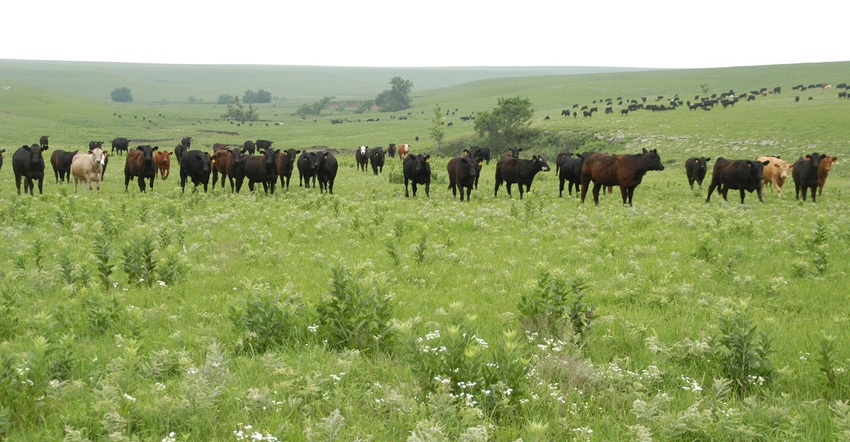October 12, 2017

It’s a beautiful sight to see cows grazing lush pastures in the spring, knowing they are taking in solid, smooth forage with great nutrients.
What ranchers can’t see are those tiny, pesky parasites looking for a host in their favorite cow. It’s a huge burden to manage internal parasites in cattle, but if it is not done before and during those lush spring grazing periods, then the reality will hit home during summer heat and stress.
The need to control internal parasites will exist as long as cattle are grazing pastures. However, parasite levels are not the same on all pastures, or in all cattle. Pastures that are heavily stocked generally have a higher parasite burden than lightly stocked ones. Cattle in a drylot are less likely to have heavy worm infections than those on pastures. Young cattle will typically have more internal parasites than older cattle. Therefore, timing and methods for controlling internal parasites are parts of a program each rancher should develop individually.
Know parasites' life cycles
Ranchers must understand the life cycle of problem parasites and be able to identify seasonal changes in parasite burdens before they can implement cost-effective control. A successful deworming program, along with good overall herd management, will increase milk production in cows, which can then increase weaning weights of calves.
Merck Animal Health says there are several effects of internal parasites that are overlooked in beef cattle. Poor nutritional status is one effect that can mean a cow has less ability to respond to microbial disease challenges. Parasites decrease feed intake and nutrient absorption, and they increase the nutrient requirements of the animals. These are also the ways parasites impact the energy, protein, vitamin and mineral status of the animals.
The largest effect that internal parasites have on beef cattle production is a reduced feed intake. Cattle with low parasite burdens have been shown to have depressions in feed intake of up to 3.2%, while cattle with high parasite burdens have been shown to have depressions in feed intake of up to 7.8%. Less feed intake means the animals are consuming less energy, protein, vitamins and minerals, all of which play a role in animal growth, reproduction and immune function. The effects are even more far-reaching, as reduced nutrient intake and absorption of an infected animal contributes to its ability to respond to other diseases as well.
Parasites have a detrimental effect on the gastrointestinal tract, which means they increase the pH of ruminants. When this happens, the density of the mucus-secreting goblet cells increases within 60 days. As the intestinal wall and lymph nodes thicken, a severe immune response is probably taking place. Some parasites also take over other parts of the gastrointestinal tract, and their presence can be associated with damage and inflammation in those areas as well.
Treat animals for parasites
One of the biggest effects of internal parasites is the toll it takes on energy. Reduced feed intake means a reduction in intake of calories (or energy) for maintenance of body weight, growth and reproduction.
Luckily there are preventative and treatment options. A technical paper provided by Merck Animal Health shows a using dewormer like Safe-guard (fenbendazole) plus Ivomec (ivermectin) pour-on means that an animal is 20% less likely to be repulled for treatment, when compared to cattle treated only with Ivomec.
Merck Animal Health reps also encourage a comprehensive approach to the control of endo- and ecto-parasites to help veterinarians and farmers establish effective parasite management programs to protect the well-being of the herd.
Here are a few other product mentions to keep a cow herd in good internal shape. Butox will prevent and treat flies, lice, keds and ticks on cattle and sheep. Pancur is a popular broad-spectrum anthelmintic, which contains fenbendazole. Safeguard is a common dewormer for beef and dairy cattle, which contains fenbendazole. Taktic helps control of ticks, mange mites, lice and keds on cattle, sheep, goats and pigs.
Pasture management is also effective to control internal parasites. Pasture management practices may reduce the parasite burden in cattle; however, this method alone will not guarantee parasite eradication. Suggestions here include moving more susceptible younger cattle to a safe pasture, which is a pasture that has not been grazed during the last 12 months. When a pasture is untilled and then plowed, contamination can drop quickly. The Merck Animal Health technical paper says to always deworm cattle prior to placement on a safe pasture; otherwise, the pasture can immediately become contaminated.
Mature cattle, which are less susceptible to parasites, can be placed on more contaminated pastures. Mature cows under a good nutrition program develop some acquired immunity to parasites, and they are affected less by the presence of parasites than young cattle and calves.
Simply, don’t overgraze pastures. Animals on overgrazed pastures graze closer to the ground and pick up more larvae. Rotational grazing systems are unlikely to provide enough rest to paddocks to reduce possible contamination. Some studies have shown that rotational grazing can increase infection compared to continuous stocking. This is likely, since rotational grazing allows higher stocking rates. However, rotational grazing combined with a strategic deworming program can still provide more production per acre than conventional grazing. If flukes are a problem, identify ways to increase pasture drainage and fence off problem areas, such as ponds.
Keeping those pesky parasites away is the best plan to avoid reduced feed intake, protect milk protection and keep calves growing. Make sure to follow a consistent program that is given to your livestock every 30 days for best results.
McCurry writes from Colwich, Kan.
You May Also Like




